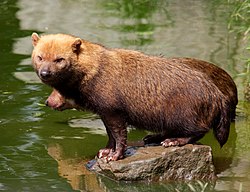| Canins | |
|---|---|
 | |
| Canina (represented by the golden jackal) and Cerdocyonina (represented by the crab-eating fox) | |
| Scientific classification | |
| Domain: | Eukaryota |
| Kingdom: | Animalia |
| Phylum: | Chordata |
| Class: | Mammalia |
| Order: | Carnivora |
| Family: | Canidae |
| Subfamily: | Caninae |
| Tribe: | Canini Fischer de Waldheim, 1817 [2] |
| Genera [1] | |
| |
Canini is a taxon which represents the dog-like tribe of the subfamily Caninae (the canines), and is sister to the fox-like tribe Vulpini. The Canini came into existence 9 million years ago. This group was first represented by Eucyon, mostly by Eucyon davisi that was spread widely across North America [1] and is basal to the other members of the tribe. [3] Its members are informally known as true dogs.

























